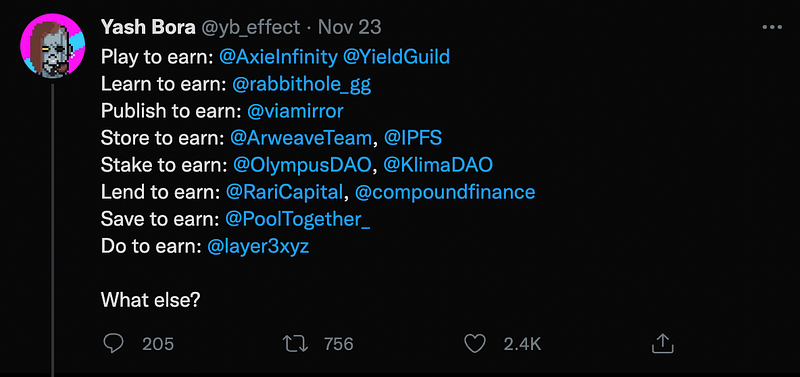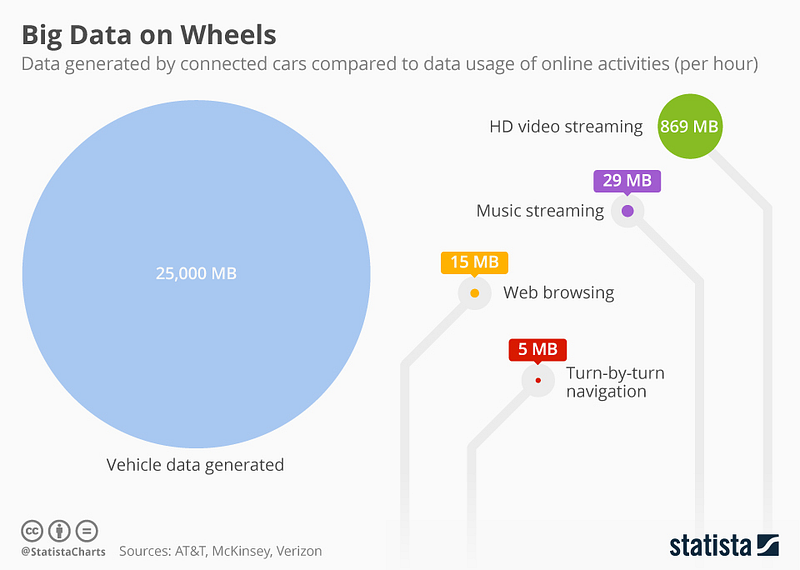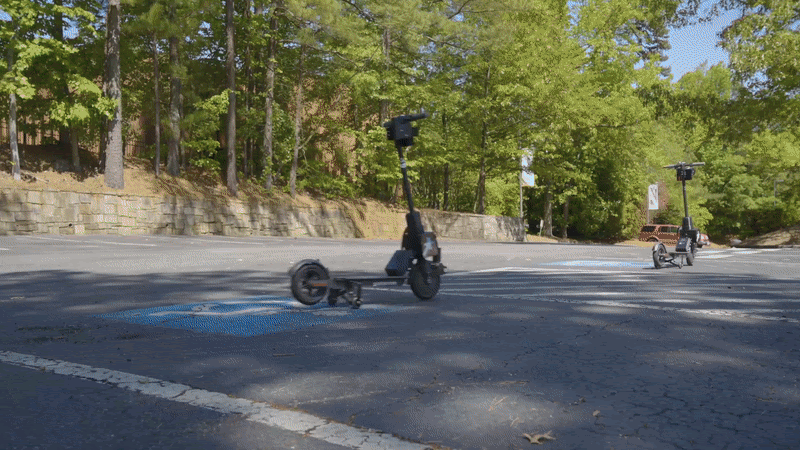Proof-of-Movement
How and why DIMO is rewarding drivers for sharing their vehicle data
The web3 world has seen an exciting explosion in “X-to-Earn,” a model that rewards network users for their participation. The basic idea: by using and providing value to a network, an individual or organization can earn income or even ownership stakes in that network.

This is a revolutionary shift in how users interact with the web. As a web3-native organization, DIMO is founded on the principles fueling this revolutionary shift. We believe that DIMO users should be rewarded for the value they add to the DIMO network — solving the “Platform Problem”.

Which is why we’re excited to introduce the concept of Drive-to-Earn to the world, built on a new implementation of an old idea called Proof-of-Movement.
The Drive-to-Earn implementation of Proof-of-Movement is similar to any other X-to-Earn concept: DIMO enables users to collect and share verified data from IoT devices (their cars) to prove that something happened in the real world. In exchange they can receive the network’s native $DIMO tokens.

Sharing Your Vehicle Data
Getting started is easy. Drivers create an account and add their car to DIMO. This information is securely stored in an encrypted database. In a few weeks DIMO will offer a simple, software connection that allows users to start collecting their vehicle data. We’re also rolling out a hardware-based connection, much like a Helium hotspot, that allows users to collect even richer data directly from their car’s data port (called an OBD2 port).
To those who have not considered automotive data before (which is most people), the value in Drive-to-Earn may not be immediately obvious. The fact is, cars produce a ton of data:

This amount is going up rapidly as cars become crammed with more and more sensors, cameras, and technology like driver assist systems.
This data is immensely valuable (if you can access it and put it to work). Vehicles are the most expensive IoT devices most people own. Understanding the inner workings of the subsystems of the car and what’s happening outside the car (via other sensors and cameras) can produce an incredible amount of insight about the world around us and how people and goods are moving in the world.
Simply put, car data is worth collecting, and it’s critical to make sure people can earn for sharing that data. We’re actively building apps that make it useful.
Market forces will impact Drive-to-Earn
Right now, DIMO is setting aside token rewards out of the initial token issuance for users, and the DAO is helping to create initial demand for that data. More importantly, we’re also building a platform that will allow developers and enterprises to create their own demand for data. This means that as an economy emerges around the DIMO platform, the rewards for Drive-to-Earn will adjust dynamically with demand-driven market forces.
To illustrate: today DIMO is rewarding new, electric vehicles with a higher share of available rewards. We believe that the data from EVs is particularly valuable since the batteries and battery management systems — which have been developed at the cost of tens of billions by automakers — are so new and so riddled with problems. But as DIMO becomes a market system, those who want different data may choose to incentivize new Drive-to-Earn rewards for different vehicle types, like automated trucks, or vehicles operating in peer to peer carsharing/ridehailing networks.
As we think about how big the market system for DIMO can be, we can see that Drive-to-Earn is really a subset of a broader category that DIMO will reintroduce: Proof-of-Movement.
Proof-of-Movement
The world of mobility is much more than cars and it’s expanding faster than ever. It includes vans, trucks, buses, trains, bikes, scooters, drones, and robots for more categories than can be counted, like pizza delivery, or remotely controlled scooters.

All of these devices are designed to move people or goods reliably and those “service oriented” movements are most valuable to understand. If you think about the “trips” that matter in your life — a drive you took, a package you had delivered, or going further back a supply chain trip that brought the goods you ordered to a fulfillment center — you realize that there is no single infrastructure where these trips can be logged and verified. Every company has their own walled garden and all are forced to trust one another that their data is accurate when they need to interoperate. There is a better way.

Beyond just verifying trips, we also need to think about creating trips. Connected devices are a two way street — we can send data both to them and from them. Sending data to a car or drone will likely involve asking it to execute some command: unlock the doors, park itself, or go rendezvous with a different robot to exchange packages.
This is what inspires DIMO: creating a standard platform where Proof-of-Movement can be established and verified on a blockchain.
This will turn the countless walled garden systems that every device maker uses today into an open and composable ecosystem. This new infrastructure — the DIMO Network — will enable innovators around the world to upgrade mobility infrastructure just as defi is upgrading financial architecture.
Once again, this is not a new idea but a new implementation, and we’re looking to other relevant projects to add “Layers” to DIMO Proof-of-Movement NFTs.
Case Study: PoM and Parking
Proof-of-Movement is a concept that will enable a very wide range of applications, but let’s start by tackling one: Automated Parking.
Let’s say you want to enable a car to drop off its driver someplace like an airport and then go find a parking space — without anyone inside.

At least a half-dozen parties need to agree to and coordinate around a shared version of reality for a car to find an appropriate space and navigate safely. For example: Where is the driverless vehicle located? What are the rules of the road? Where is there available parking? Are there any parking fees?
🚙 Equipment Manufacturers (OEMs): Controls systems in the car need to respond to instructions and input from users, 3rd party operators, and external sensors. Errors need to be shared.
📊 Lot Owners: Price and availability is shared properly with current and potential users.
👩💻App Developers: Interfaces can be built into existing mobility or travel apps.
🏛 Regulators: Incidents and safety issues need to be shared without compromising privacy.
🅿️ Lot Operators: Realtime state of a lot needs to be communicated to users and owners. Backup controls need to be available to local lot attendants.
🏢 Insurance Company: Receive data on risk to appropriately triage risk and price policies.
👨👩👧👦 Vehicle Owners: Know their vehicle is stored safely and collect it when it returns.
In isolation, this problem may not seem particularly challenging, but at a global scale it’s daunting. Dozens of automakers, hundreds of hardware and software companies, transportation operators, real estate managers, and more need to interoperate to make even a simple application like this globally scalable so that each implementation is not replicating efforts by building from scratch each time.

Proof-of-Movement enables the creation of immutable and open data that is a key building block for any complex mobility application.
We’re also building a number of other applications and use-cases on these primitives, and we’d love to have you join the DIMO movement to accelerate the adoption of a more open and accessible mobility network.
Get Involved with DIMO
You can sign up for a DIMO account and add a vehicle (or vehicles). We’ll notify you when we’re ready to help you connect your car, which should only be a few weeks.
Build with DIMO
If you’re looking to join the DAO and community, you can find us on Discord. We also know that there’s great interest in deciphering and understanding car data — so in addition to those who want to send us vehicle data, we’re building a community around those who want to decode vehicle data. Car hackers and tinkerers around the world who have been working on this for years? There’s a place for you in DIMO, too.
Hop in and join us: https://dimo.zone.
Andy Chatham has spent 10 years in the mobility space operating some of the largest autonomous and electric vehicle fleets, and building software used by millions of passengers. Before DIMO, he worked for Transdev managing a team of hundreds working on Waymo—Google’s self-driving car division. He’s also worked across many other domains in the mobility world, helping transit and real estate partners leverage new technologies and deploy mobility-as-a-service solutions.